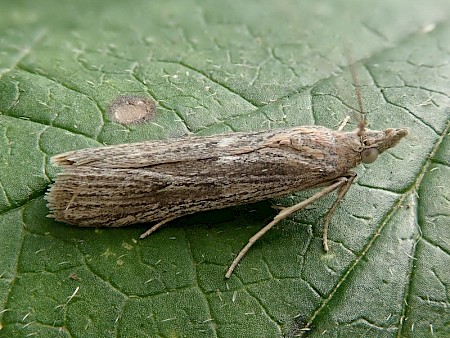62.031 BF1456
Epischnia asteris
Staudinger, 1879
Wingspan 27-30 mm.
The distribution of E. asteris, (formerly E. bankesiella), is tied to that of its larval foodplant, golden samphire (Inula crithmoides), growing on sea cliffs in S. and S.W. England and Wales, as far north as Lleyn, where it is well established. Apparently, it does not favour plants on saltings, such as those in S.E. England.
The forewing is greyish with darker striations, and the moth adopts an elongated shape when at rest.
The adults fly from dusk onwards in July, and can be attracted to light. Larvae feed in August - September, and again in April - May after overwintering.
The habitation is silk, flecked with frass, which may form a flimsy tube running down the plant. When disturbed, the larva may throw itself from the habitation. Pupation is in a cocoon among detritus in June and early July.
- Larva: (description Ian F. Smith):
Foodplant: Inula crithmoides on cliffs. Aug. - May, (diapausing Oct. - March).
Length: 15 mm described. May. Head: Brownish yellow heavily mottled dark purple. Mouthparts not mottled. Stemmata and stemmatal area coloured similarly to head, difficult to distinguish.
Thorax: Coloured as abdomen, with more pronounced greenish tint.
Prothoracic shield: Brownish yellow, heavily mottled purplish black. A flexible border in front of the shield, visible when head extended, is yellowish tinted green with seven purplish longitudinal lines (not exposed in site pictures).
Thoracic legs: Yellowish tinted green, with black on outer face, especially on tibia.
Body: Brownish purple with discontinuous subdorsal, dorsolateral, lateral, supraspiracular and subventral yellowish lines, which are tinted greenish laterally and intersegmentally.
Spiracles: Blackish brown.
Pinacula: Black with slight rusty staining on periphery. Lateral pinaculum on segment A8, and dorsolateral pinaculum on T2 are larger than other pinacula and have a large white central area.
Setae: Transparent pale grey. Anal segment: No anal comb. Anal plate almost covered in black pigment.
Prolegs: Base as venter. Planta translucent yellowish tinted green. Crochets reddish brown. Anal proleg has black markings on base, and a pale purple planta.

 UKMoths
UKMoths 





